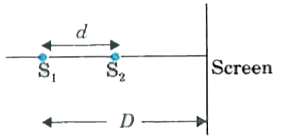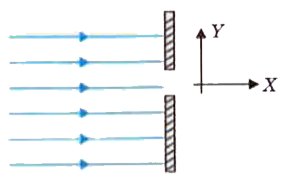Complete Solutions to OBJECTIVE TYPE QUESTIONS (JEE (MAIN) & OTHER STATE BOARDS FOR ENGINEERING ENTRANCE) of chapter WAVE OPTICAL of Class 12 book with complete answers and questions
| Class 12 | PHYSICS |
| Chapter | WAVE OPTICAL |
| MODERN PUBLICATION | OBJECTIVE TYPE QUESTIONS (JEE (MAIN) & OTHER STATE BOARDS FOR ENGINEERING ENTRANCE) |
| Number Of Questions | 22 |
| Academic Year | 2023-24 |
Unpolarized light of intensity `I` is incident on a system of two polarizers, A followed by B. The intensity of emergent light is `I//2`. If a third polarizer C is placed between A and B the intensity between the polarizers A and C is `theta`, then
View SolutionLights of wavelength 550 nm falls normally on a slit of width k`22.0 xx 10^(-5) cm`. The angular position of the central maximum will be (in radian) :
View SolutionUnpolarised light of intensity I passes through an ideal polariser A. Another identical polariser B is placed behind A. The intensity of light beyond B is found to be `I/2`. Now another identical poariser C is placed between A and B. The intensity beyond B is now found to be `I/8`. The angle between polariser A and C is :
View SolutionIn an interference experiment the ratio of amplitudes of coherent waves is `a_1/a_2=1/3` The ratio of maximum and minimum intensities of fringes is …………..
View SolutionIn Young's double-slit experiment, one of the slit is wider than other so that the amplitude of the light from one slit is double of that from other slit. If `I_m` be the maximum intensity, the resultant intensity `I` when they interfere at phase difference `phi` is given by:
View SolutionCalculate the limit of resolution of a telescope objective lens having a diameter of 200 cm, if it has to detect light of wavelength 500 nm coming from a star.
View SolutionTwo coherent point sources `S_1 and S_2` are separated by a small distance 'd' as shown. The fringes obtained on the screen will be :

View SolutionTwo beams, A and B, of plane polarised light with mutually perpendicular planes of polarisation are seen through a polarised light with mutually perpendicular planes of polarisation are seen through a polaroid. From the position when the beam A has maximum intensity (and beam B has zero intensity). a rotation of Polaroid through `30^@` makes the two beams appear equally bright. If the intiial intensities of the two beams are `I_A and I_B` respectively, then `I_A//I_B` equals :
View SolutionOn a hot summer night, the refractive index of air is smallest near the ground and increases with height from the ground. When a light beam is directed horizontally, the Huygen's principle leads us to conclude that as it travels, the light beam
View SolutionA parallel beam of electrons travelling in X-direction falls on a slit of width d (see figure). If after passing the slit, an electron acquires momentum `p_y` in the Y-direction, then for a majority of electrons passing through the slit (h is Planck's constant):

View SolutionAn object is located in a fixed position in front of a screen. Sharp image is obtained on the screen for two positions of a thin lens separated by 10 cm. The size of the images in two situtation are in the ratio 3 : 2. What is the distance between the screen and the object?
View SolutionTwo monochromatic light beams of intensity 16 and 9 units are interfering. The ratio of intensities of bright and dark parts of the resultant pattern is:
View SolutionIn a Young's double-slit experiment with light of wavelength `lambda`, the separation of slits is d and distance of screen is D such that `D > > d > > lambda`. If the Fringe width is `beta`, the distance from point of maximum intensity to the point where intensity falls to half of maximum intensity on either side is :
View SolutionUnpolarised light of intensity `I_0` is incident on surface of a block of glass at Brewster's angle. In that case which one of the following startements is true?
View SolutionIn an experiment of single slit diffraction pattern, first minimum for red light coincides with first maximum of some other wavelength. If wavelength of red light is `6600 Å`, then wavelength of first maximum will be:
View SolutionIn a Young's double-slit experiment, the distance between the two identical slits is 6.1 times larger than the slit width. Then the number of intensity maxima observed within the central maximum of the single slit diffraction pattern is :
View SolutionIn Young's double-slit experiment, the distance between slits and the screen is 1.0 m and monochromatic light of 600 nm is being used. A person standing near the slits is looking at fringe pattern. When the separation between the slits is varied, the interference pattern disappears for a particular distance `d_0` between the slits. If the angular resolution of the eye is `(1/(60))^(@)` , the value of `d_0` is close to :
View SolutionTwo stars are 10 light years away from the Earth. They are seen through a telescope of objective diameter 30 cm. The wavelength of light is 600 nm. To see the stars just resolved by the telescope, the minimum distance between them should be (1 light year = `9.46 xx 10^(15)m)` of the order of :
View SolutionThe box of a pinhole camera, of length L, has a hole of radius a. It is assumed that when the hole is illuminated by a parallel beam of light of wavelength `lambda`. The spread of the spot (obtained on the opposite wall of the camera) is the sum of its geometrical spread and the spread due to diffraction. The spot would then have its minimum size (say `b_("min")`) when :
View SolutionA single slit of width b is illuminated by a coherent monochromatic light of wavelength `lambda`. If the second and fourth minima in the diffraction pattern at a distance 1 m from the slit are at 3 cm and 6 cm respectively from the central maximum, what is the width of the central maximum? (i.e., distancebetween first minimum on either side of the central maximum)
View SolutionA single slit of width 0.1 mm is illuminated by a parallel beam of light of wavelength `6000 Å` and diffraction bands are observed on a screen 0.5 m from the slit. The distance of the third dark band from the central bright band is:
View SolutionIn a Young's double slit experiment, slits are separated by `0.5 mm` and the screen is placed `150 cm` away. A beam of light consisting of two wavelengths, `650 nm` and `520 nm`, is used to obtain interference fringes on the screen. The least distance from the commom central maximum to the point where the bright fringes fue to both the wavelengths coincide is
View Solution
OBJECTIVE TYPE QUESTIONS (JEE (MAIN) & OTHER STATE BOARDS FOR ENGINEERING ENTRANCE) questions and complete solutions for chapter WAVE OPTICAL of MODERN PUBLISHERS PHYSICS (HINGLISH) of Class 12
All Exercises from MODERN PUBLICATION Class 12 PHYSICS WAVE OPTICAL
- CHAPTER PRACTICE TEST
- Conceptual Questions
- Higher Order Thinking Skills & Advanced Level (QUESTIONS WITH ANSWERS)
- NCERT (EXemplar Problems Obejective Questions) (Multiple Choice Questions (Type-I)
- NCERT (EXemplar Problems Obejective Questions) (Multiple Choice Questions (Type-II)
- NCERT (Exemplar Problems Subjective Questions) (Short Answer Type Questions)
- NCERT (Exemplar Problems Subjective Questions) (Very Short Answer Type Questions)
- NCERT FILE SOLVED (Additional Exercises)
- NCERT FILE SOLVED (TEXT BOOK EXERCISES)
- OBJECTIVE TYPE QUESTIONS (A. MULTIPLE CHOICE QUESTIONS)
- OBJECTIVE TYPE QUESTIONS (ASSERTION REASON TYPE QUESTIONS)
- OBJECTIVE TYPE QUESTIONS (B. MULTIPLE CHOICE QUESTIONS) -AIPMT/NEET & OTHER STATE BOARDS FOR MEDICAL ENTRANCE
- OBJECTIVE TYPE QUESTIONS (C. MULTIPLE CHOICE QUESTIONS)
- OBJECTIVE TYPE QUESTIONS (D. MULTIPLE CHOICE QUESTIONS)
- OBJECTIVE TYPE QUESTIONS (INTEGER TYPE QUESTIONS)
- OBJECTIVE TYPE QUESTIONS (JEE (ADVANCED) FOR IIT ENTRANCE)
- OBJECTIVE TYPE QUESTIONS (JEE (MAIN) & OTHER STATE BOARDS FOR ENGINEERING ENTRANCE)
- OBJECTIVE TYPE QUESTIONS (MATCHING TYPE QUESTIONS)
- OBJECTIVE TYPE QUESTIONS (MATRIX MATCH TYPE QUESTIONS)
- PRACTICE PROBLEMS (1)
- PRACTICE PROBLEMS (2)
- PRACTICE PROBLEMS (3)
- PRACTICE PROBLEMS (4)
- Revision Exercises (Additional Questions)
- Revision Exercises (Fill in the Blanks)
- Revision Exercises (Long Answer Questions)
- Revision Exercises (Numerical Problems)
- Revision Exercises (Short Answer Questions)
- Revision Exercises (Very Short Answer Questions)
- SOLVED EXAMPLES
- Tough & Tricky (PROBLEMS)